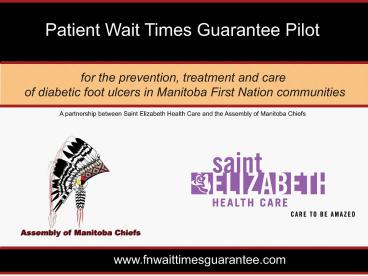Click here to add title - PowerPoint PPT Presentation
1 / 31
Title:
Click here to add title
Description:
SEHC and AMC are committed to working together in a partnership framework. ... Thank you. Miigwech. Ekosani. Mahsi. Wopida. www.fnwaittimesguarantee.com ... – PowerPoint PPT presentation
Number of Views:33
Avg rating:3.0/5.0
Title: Click here to add title
1
(No Transcript)
2
The Wait Times Guarantee Pilot
- Partnership between the AMC and SEHC
- Funded by Health Canada
- Goal is to reduce the significant impacts of foot
ulcers and amputations in MFNs by establishing
and implementing a wait times guarantee for the
prevention, treatment and care of diabetic foot
ulcers.
3
Working Towards a Common Goal
- SEHC and AMC are committed to working together in
a partnership framework. - Collaboration agreement, based on the FNs
principles of Ownership, Control, Access, and
Possession. - Recognizes and emphasizes MFN cultural values and
perspectives. - Endeavors to consider all effective options,
including traditional healing.
4
Partnership Model
- Community Partners
- AMC/SEHC Project Coordinators
- MFN Advisory Committee
- AMC/SEHC Steering Committee
- Project Team
- Working groups established with diverse and
representative stakeholders
5
Project Phases and Timeline
6
Framework for Building a Testable Model
7
Brokenhead Ojibway Nation
Canupawakpa Dakota Nation
Wasagamack First Nation
Sayisi Dene First Nation
Sandy Bay Ojibway First Nation
Ebb Flow First Nation
Community Partners
Peguis First Nation
Manto Sipi Cree Nation
Opaskwayak Cree Nation
8
(No Transcript)
9
Gathering the Evidence Engaging Key Stakeholders
PWTG Foot Care Strategy Framework
10
(No Transcript)
11
Community Visits
12
Community Visits
13
Gathering of Traditional Healers
14
The Evidence
Profile of Foot Care in Manitoba First
Nations major themes
Profile of Pilot Community Models waits,
barriers, assets
Best Practice in Diabetes Foot Care
15
Waits for Foot Care
- Primary Care System
- Primary Care System
- Hospital System
- Private System
16
Major Barriers to Foot Care
Availability Access to Care
- Resources
- Shortage of physicians nurses
- Limited access to specialist physicians
- Lack of affordable footwear
- Lack of affordable transportation
- Food scarcity
- Capacity
- Limited pool of trained foot care providers
- Gatekeepers lack current knowledge
- Nurse expertise underutilized
- Lay providers underutilized
- Limited training opportunities
17
Delivery of Care
- Delivery of Services
- Limited provision of primary foot care in
communities - Diabetes education not community specific
- Practice of Providers
- Substandard foot care
- Duplication of care
18
- Information
- Medical record systems not centralized
- Information systems not linked across
jurisdictions - Lack of formal diabetes registries
- Organization
- Lack of coordination/continuity between programs
systems - Lack of triaging system
- Traditional medicine
- disconnected
Coordination of Care
- Communication
- Limited collaboration between nurses and
physicians - Limited communication between nurses and
physician specialists - Limited exchange of info between providers and
people in communities
- Referral Systems
- Limited autonomy of nurses
- Late referral to specialists
- Variable referral criteria
19
Participation of People
- Use of Health Services
- People do not connect with primary care system
- People seek care late
- People refuse or do not adhere to treatment
- Self-Care
- Disability
- Lack of access to basic resources
20
Political Economic Environment
- Policy
- Limited coverage of basic footwear
- Cutbacks to medical transportation services
limit access to services
- Funding
- Limited funding levels for adequate and
effective primary foot care - Decentralized programs
21
Community Assets
- Integrated foot care programs
- Multidisciplinary teams
- Partnerships/links with external resources
- Links with traditional medicine
- Expertise of nurses
- Autonomy in nurse practice
- Knowledge understanding of local culture
- Innovation in program delivery
- Strategic use of funding
22
Community Models of Foot Care Distinct points
of resilience points of change
23
Application of Evidence Building a Framework
for Foot Care
Points of Resilience Change
Strategies
- Communication process
- Information systems
- Partnerships/Links
- Practice patterns
- Capacity
- Referral systems
- Organization of care
- Use of health services
- Availability of Access
- to resources
- Funding systems
- Policy
- Jurisdiction
24
Foot Care Strategies
- Facilitate best practice in prevention, care and
treatment - Centralize information systems in communities
- Link information systems across jurisdictions
Information Management
25
Foot Care Strategies
- Knowledge Exchange
- Advance knowledge of foot care providers
- Share expertise innovation
- Establish consensus on benchmarks of diabetes
foot care - Improve access to education
Partnership Network
- Streamlined Communication
- Facilitate integrated, coordinated delivery of
foot care - Establish timely, accessible referral paths
26
Foot Care Strategies
- Promote early upstream engagement
- Downstream support
- Individualized, client directed prevention, care
and treatment - Support for navigating health system
- Peer support and advocacy
- Language communication/support
Engagement of People
27
Foot Care Strategies
- Equitable levels of funding distribution of
funds for primary foot care - Flexible allocation of funds
- Investment in upstream resources affordable
footwear - Support of timely and accessible care medical
transportation
Review of Policy
28
Strengthening Community Models Seeds of Change
Brokenhead
Canupawakpa
Wasagamack
Information Management
Partnership Network
PWTG Foot Care Strategy
Ebb Flow
Sandy Bay
Engagement of People
Policy Review
Manto Sipi
Peguis
Opaskwayak
29
Gathering of 8 First Nation Communities
30
Final Thoughts
- Investment in partnership building and
stakeholder engagement is critical - Multiple, community-specific strategies are
needed - Innovations
- Honoring OCAP principles
- Practical Solutions but need resources
- Sustainable funding needed
- First Nations have the answers- care to
imagine?
31
- Thank you
- Miigwech
- Ekosani
- Mahsi
- Wopida
www.fnwaittimesguarantee.com































